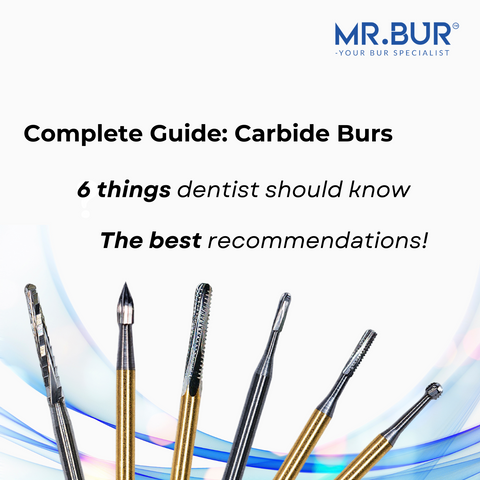As virtually every dentist knows, burs are essential dental instruments. Positioned on a dental drill, the bur's ultra-fast rotation cuts through teeth enamel, allowing dentists to remove plaque and prepare teeth for a wide range of procedures, from cavity fillings to crown fillings and more.
Dental burs are used alongside countless other dental tools in the dentistry toolkit for a wide number of applications, and therefore are quite diverse in material, shape and diameter. In this article, we will focus on two main bur types: dental diamond burs and dental carbide burs. Our goal is to define the difference between the two bur types, and understand each type's unique advantages.
What are Diamond Burs?
Diamond burs are made from diamond grit. They are very powerful and precise, and can grind through hard tissue with great precision. They are the preferred choice of dentists worldwide for grinding through natural teeth enamel – as well as ceramics such as porcelain – as preparation for crown fittings. The precision of diamond burs ensures that the tooth's inner pulp tissue is not damaged in any way.
The diamond bur grind is rather coarse, and usually leaves a "rough" end result. Often, this coarseness is not an important factor. Like sandpaper, Dental diamond burs come in different diamond grit surface densities. Dentists that want to achieve smoother results will use burs with high surface densities.
What are Carbide Burs?
Carbide burs are made from a super-hard, extremely resistant chemical compound called tungsten carbide (WC). It is much harder than steel, which makes it an excellent material for drilling and cutting. As a result, tungsten carbide is used extensively in various applications, from machining and surgeries to dentistry.
The use of carbide burs in dentistry has become very common. This isn't very surprising, primarily because tungsten carbide burs are great tools for preparing teeth for cavity fillings or removing fillings. They cut swiftly through the teeth, and remove elements that may interfere with the filling, including plaque. They are also very helpful in removing and replacing fillings. Because they cut rather than grind, carbide burs create smoother surface environments than diamond burs.
Carbide and Diamond Burs: Main Differences
-
Precision: When it comes to precision, the diamond bur grind trumps carbide bur cutting. With diamond burs, there is also a lesser chance of impacting the tooth's inner pulp area.
-
Durability: Both diamond and WC are extremely strong materials. Yet carbide burs are more durable and tend to have a longer lifecycle. They are also more resistant to heat.
-
Surface: If you're looking to create a smooth tooth surface, then you should work with carbide burs. In comparison, the diamond bur grind creates a coarse and rugged environment.
-
Zirconia cutting burs: Cutting and removing zirconia crowns can be rather difficult. With their high-speed grind, diamond burs are better equipped for the job than carbide burs. The same can be said for cutting ceramic crowns.
When Should Each Bur Be Used?
The answers to this question are highly subjective. Every dentist has his or her personal preferences and list of best practices. That said, a majority of experienced dentists can agree that diamond burs are better than carbide burs in certain scenarios, and vice versa.
Diamond burs in dentistry are commonly considered as excellent tools for precision cutting through enamel and ceramics, especially in certain procedures that concern crown removal or fitting. Generally speaking, when a dental procedure requires ultra-precision cutting, then diamond burs are a more popular choice than carbide burs.
Carbide burs have their advantages, as well. They are much more effective for cavity and filling procedures, and are known to be more durable in the long-run. Many dentists also prefer them because they leave a smooth, clean finish.
So, should you use diamond burs or carbide burs? That depends on the work that you perform in your clinic, as well as your level of professional expertise. It may be a good idea to familiarize yourself personally with both bur types to understand what best works for you. Conferring with other dentists and learning about their preferences is also a good idea.
The Bottom Line
To sum up, carbide and diamond burs are very different. They each have very distinct advantages. As a result, many dentist clinics alternate between carbide and diamond burs – depending on the specific scenario at hand. It's always a good idea to have many high-quality toolkits available.
At Mr. Bur, we provide both Carbide burs and Diamond burs. We pride ourselves on premium-level products with very high value-for-money. If there is something we can say with conviction, it is that we do not recommend compromising on product quality. If you're looking to buy burs for your clinic, you've come to the right place.
Diamond Burs, Carbide Burs, Surgical & Lab Use Burs, Endodontic burs, IPR Kit, Crown Cutting Kit, Gingivectomy Kit, Root Planning Kit, Orthodontic Kit, Composite Polishers, High Speed Burs, Low Speed Burs
Subscribe our newsletter now!



